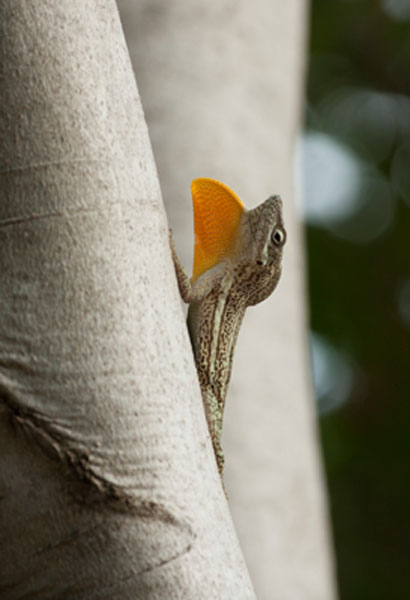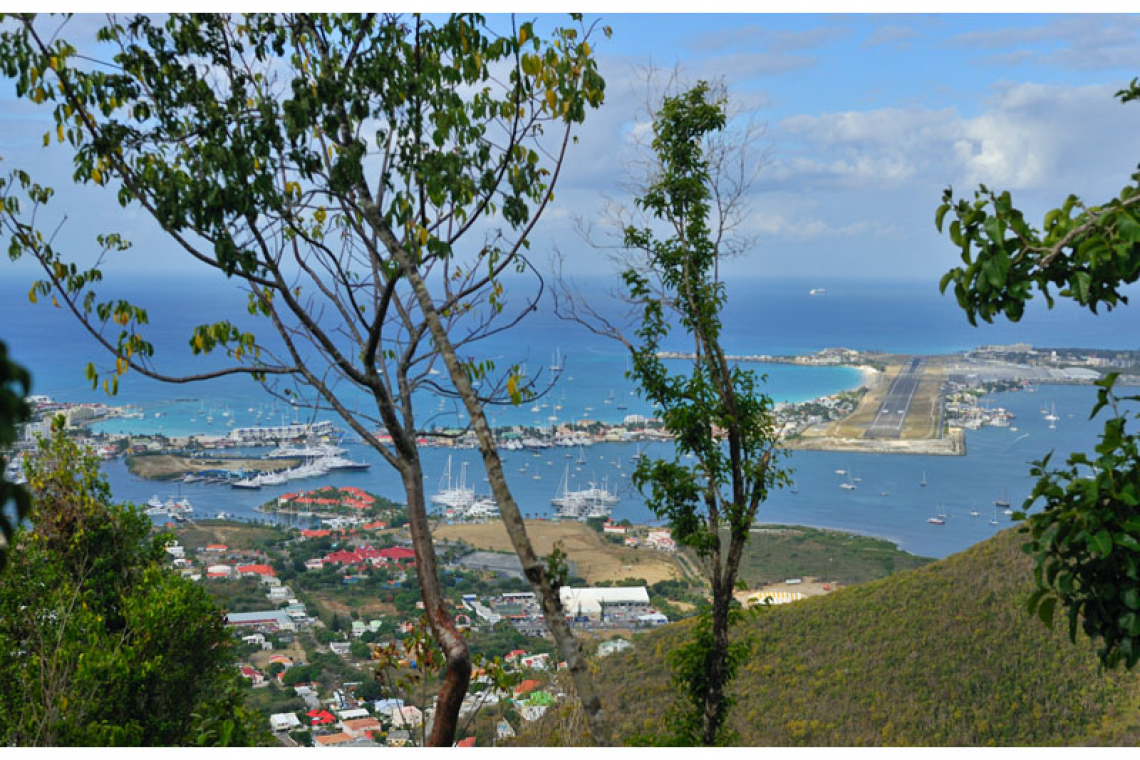Video: https://youtu.be/m4cqzEQtMA0
View from Sentry Hill over Simpson Bay Lagoon (Christian Konig photo)
PHILIPSBURG--Green vegetation cover of the Dutch-side has decreased by more than 25 per cent since 1956. This can be seen on a coloured vegetation map produced by Carmabi and Wageningen University and Research commissioned by Ministry of Public Housing, Spatial Planning, Environment and Infrastructure (VROMI).
By investigating and mapping the vegetation of the island, spatial planning strategies can be developed to protect and connect the remaining sensitive landscape ecological units, to prevent further loss of biodiversity and vital natural resources. Results of research on St. Maarten show that the loss of vegetation can be attributed to massive urbanization and touristic development, overgrazing by goats, the impact of hurricanes and the negative effect of invasive plant species.
According to Carmabi, vegetation maps are a useful tool in understanding the status of the biodiversity and species make-up of a particular area. “These maps are used by a wide variety of stakeholders, from scientists to policy makers, and are key to spatial planning and designing nature management and conservation strategies. This gains extra relevance based on the fact that St. Maarten is a biodiversity hotspot in the Caribbean area.”
Sint Maarten is home to two species of Anolis lizards, A. gingivinus and A. pogus, the Anguilla and Bearded anole respectively. (Marjolijn Lopes Cardozo photo)

The island is inhabited by more than a hundred species which can only be found within the Lesser Antilles region and twelve species which can only be found on St. Maarten, research from Carmabi showed. Furthermore, the vegetation types that are associated with the hilly landscape, the dominant landscape on St. Maarten, belong to the most threatened ecosystems in Latin America and worldwide.
A well-developed natural vegetation plays a critical role in securing balanced and healthy ecosystems, researchers stressed. Areas with such a vegetation influence soil property, prevent erosion, aid in water retention and provide important buffers between land and sea, preventing damage to coral reefs by sedimentation. Natural vegetation is also key for providing food and shelter for a wide variety of the island’s native animal populations.
The results of an island-wide field study done in 1999, showed that in comparison to a vegetation map published in 1956, a twenty-five-per-cent decline in vegetation cover has taken place. In addition, five different vegetation types found in coastal areas have disappeared beyond recognition over those four decades.
“The interconnectedness of ecosystems on islands make them vulnerable to the impact of habitat loss and fragmentation, as well as the negative impact of grazing by introduced mammal grazers and invasive plant species,” Carmabi stated. “Of course, we must not forget the detrimental effects of hurricanes and global warming.”
Over time, habitat loss and fragmentation on St. Maarten have been caused by agriculture, grazing by introduced mammals, and since the 1960s by an explosive growth in tourism. Particularly since 1980, tourism has skyrocketed on the island. Some vegetation units described in 1956 have also disappeared due to actual vegetation regeneration and succession to a more diverse state following the decline in agriculture and livestock grazing.
Although there has been some regeneration, the overall process witnessed for St. Maarten is that of loss of natural and semi-natural vegetated areas in all parts of the island. The largest disappearance took place in the western parts of the island that in 1956 were characterized by the presence of two evergreen vegetation types. In the Lowlands area, a climax evergreen vegetation type covering a large part of the area in 1956 has disappeared almost totally, except for a very small area still present but seriously threatened.
Large areas of a vegetation type with a deciduous character to the west of the eastern hill range have been lost, Carmabi found. “One could observe that the general trend shows that the hills are regenerating while the low and coastal areas are degrading at a faster rate, resulting in a net vegetation loss. This trend demonstrates the economic shift from mainly agricultural practices towards an economy heavily reliant on tourism.”
Vegetation maps similar to the one produced in the present report have been completed by Carmabi for other Dutch Caribbean islands as well. This includes maps of Curaçao (1997), Bonaire (2005), St. Eustatius (2014) and Saba (2016). Since the eighties land-use planning has become a hot topic, and understanding the current status of each island’s terrestrial areas is critical in both sustainable land development, as well as implementing conservation and restoration strategies moving forward.
Carmabi’s report ends with five recommendations to work towards a more effective terrestrial nature management on the island: establish a protected areas network, control of roaming livestock, protection of endangered plant species, an invasive species action plan and long-term vegetation monitoring. Findings of this report point to the importance of protecting and connecting rare and individual landscape units, such as those found in the Lowlands, and at the remaining naturally vegetated beaches. It is also clear that the landscape ecological units that are characteristic of the high hills have a high conservation value that call for protection.
For more information, you can read the full report here: https://edepot.wur.nl/537155.







